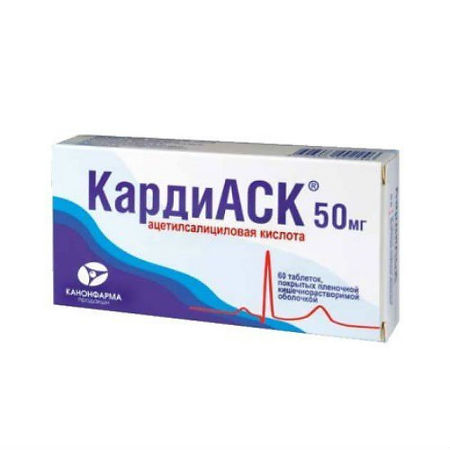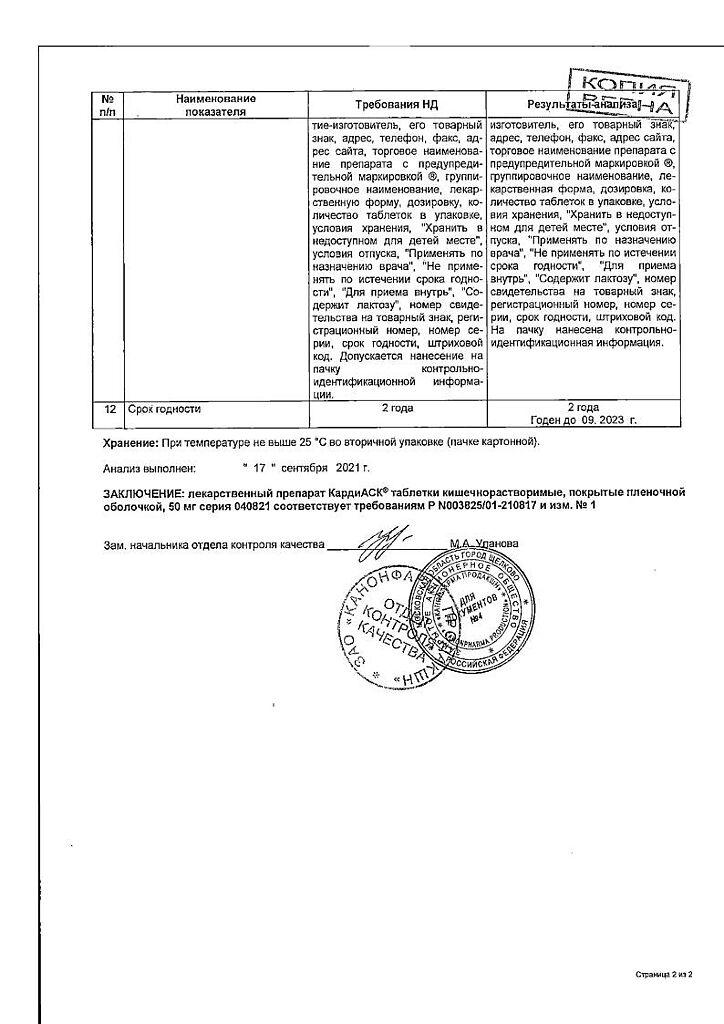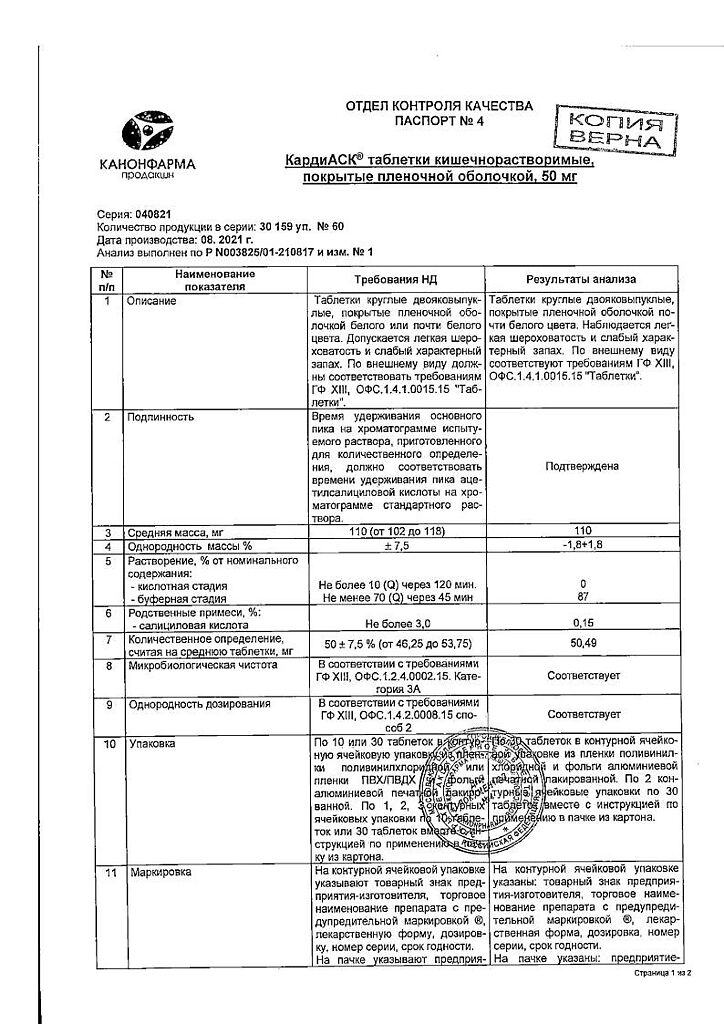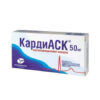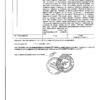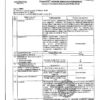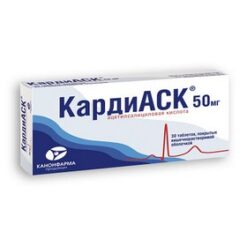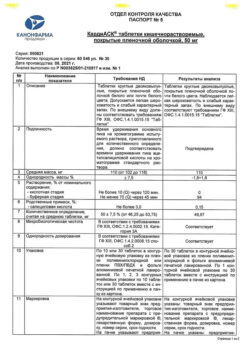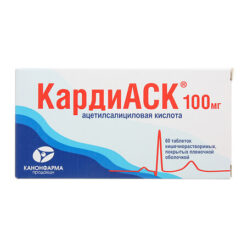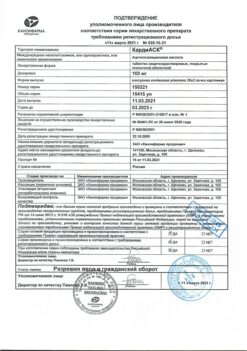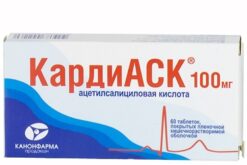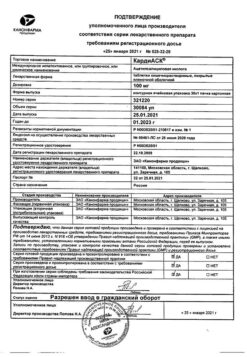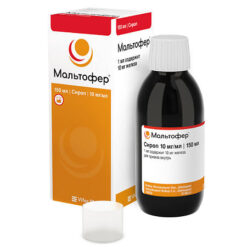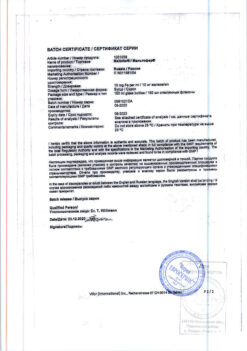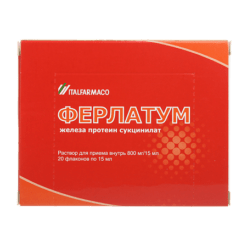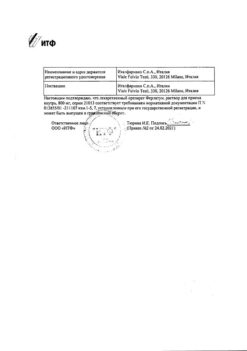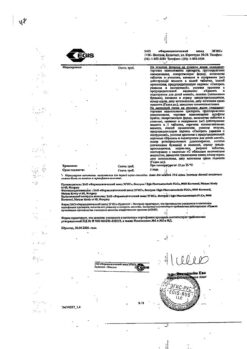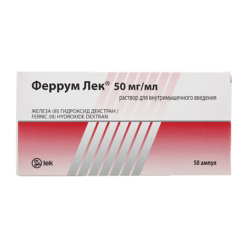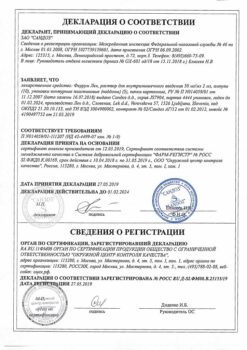No products in the cart.
CardiASC, 50 mg 60 pcs
€3.48 €3.16
Description
CardIASC is an anti-aggregative.
Pharmacodynamics
. The mechanism of antiplatelet action of acetylsalicylic acid (ASA) is based on irreversible inhibition of COX-1, resulting in blocked synthesis of thromboxane A2 and suppressed platelet aggregation. The antiplatelet effect develops even after a low dose of the drug and lasts for 7 days after a single dose. It is believed that ASA has other mechanisms of platelet aggregation inhibition, which expands the field of its use in various vascular diseases. At high doses, ASK also has anti-inflammatory, antipyretic and analgesic effects.
Pharmacokinetics
Assoc is quickly and completely absorbed from the GI tract after oral administration. ASK is partially metabolized during absorption. During and after absorption ASA is converted to the main metabolite, salicylic acid, which is metabolized mainly in the liver under the influence of enzymes to form metabolites such as phenylsalicylate, salicylic acid glucuronide and salicyluric acid found in many tissues and in urine. In women, the metabolic process is slower (lower serum enzyme activity). Tmax of ASA in blood plasma is 10-20 minutes after oral administration, and of salicylic acid – 0.3-2 hours.
Due to the fact that the tablets are covered with an acid-resistant coating, ASK is not released in the stomach (the coating effectively blocks dissolution of the drug in the stomach), but in the alkaline environment of the duodenum. Thus, absorption of Asc in the form of tablets coated with an enteric coating is delayed by 3-6 hours compared to conventional (without such a coating) tablets. Asc and salicylic acid are bound to blood plasma proteins (from 66 to 93% depending on the dose) and are rapidly distributed in the body. Salicylic acid passes through the placenta and into the breast milk.
The excretion of salicylic acid is dose-dependent because its metabolism is limited by the enzymatic system. T1/2 is from 2-3 hours when using ASA in low doses and up to 16 hours when using the drug in high doses (common doses of acetylsalicylic acid as an analgesic). Unlike other salicylates, non-hydrolyzed ASA does not accumulate in the blood serum when taking the drug repeatedly. Salicylic acid and its metabolites are excreted by the kidneys. In patients with normal renal function 80-100% of a single dose of the drug is excreted by kidneys within 24-72 hours.
Indications
Indications
Increased body temperature in various infectious and inflammatory diseases.
Pain of mild to moderate intensity of various origins.
Prevention of thrombosis and embolism (blockage of blood vessels).
Treatment of myocardial infarction and cerebrovascular accidents.
Pharmacological effect
Pharmacological effect
CardiASK – antiaggregation.
Pharmacodynamics
The mechanism of the antiplatelet action of acetylsalicylic acid (ASA) is based on irreversible inhibition of COX-1, as a result of which the synthesis of thromboxane A2 is blocked and platelet aggregation is suppressed. The antiplatelet effect develops even after the use of small doses of the drug and persists for 7 days after a single dose. It is believed that ASA has other mechanisms of suppressing platelet aggregation, which expands the scope of its use in various vascular diseases. In high doses, ASA also has anti-inflammatory, antipyretic and analgesic effects.
Pharmacokinetics
After oral administration, ASA is quickly and completely absorbed from the gastrointestinal tract. ASA is partially metabolized during absorption. During and after absorption, ASA is converted to its main metabolite, salicylic acid, which is metabolized primarily in the liver under the influence of enzymes to form metabolites such as phenyl salicylate, salicylic acid glucuronide and salicyluric acid, found in many tissues and in the urine. In women, the metabolic process is slower (less enzyme activity in the blood serum). Tmax of ASA in blood plasma is 10–20 minutes after oral administration, salicylic acid is 0.3–2 hours.
Due to the fact that the tablets are coated with an acid-resistant coating, ASA is not released in the stomach (the coating effectively blocks the dissolution of the drug in the stomach), but in the alkaline environment of the duodenum. Thus, the absorption of ASA in the form of enteric-coated tablets is delayed by 3–6 hours compared to conventional (without such a coating) tablets. ASA and salicylic acid bind to plasma proteins (from 66 to 93% depending on the dose) and are quickly distributed in the body. Salicylic acid crosses the placenta and into breast milk.
The elimination of salicylic acid is dose-dependent, since its metabolism is limited by the capabilities of the enzymatic system. T1/2 ranges from 2–3 hours when using ASA in low doses and up to 16 hours when using the drug in high doses (usual doses of acetylsalicylic acid as an analgesic). Unlike other salicylates, with repeated administration of the drug, non-hydrolyzed ASA does not accumulate in the blood serum. Salicylic acid and its metabolites are excreted by the kidneys. In patients with normal renal function, 80–100% of a single dose of the drug is excreted by the kidneys within 24–72 hours.
Active ingredient
Active ingredient
Acetylsalicylic acid
Composition
Composition
Active ingredient:
acetylsalicylic acid 50 mg;
Excipients:
stearic acid;
corn starch;
lactose monohydrate (milk sugar);
hydrogenated castor oil;
povidone (plasdon K90 or collidon 90F);
polysorbate (tween 80);
MCC;
Film shell:
methacrylic acid and ethyl acrylate copolymer 1:1 (collicut MAE 100P); macrogol and polyvinyl alcohol copolymer (collicut IR); copovidon (plasdon S630); triethyl citrate; talc; titanium dioxide
Contraindications
Contraindications
hypersensitivity to acetylsalicylic acid and other NSAIDs;
erosive and ulcerative lesions of the gastrointestinal tract;
gastrointestinal bleeding;
bronchial asthma induced by taking salicylates and NSAIDs;
“aspirin triad” (Fernand-Vidal triad: a combination of bronchial asthma, recurrent polyposis of the nose and paranasal sinuses and intolerance to acetylsalicylic acid);
hemorrhagic diathesis;
combined use with methotrexate at a dose of 15 mg per week or more;
liver failure;
renal failure;
I and III trimester of pregnancy;
lactation (breastfeeding);
age up to 18 years.
With caution:
for gout;
for hyperuricemia;
patients with a history of ulcerative lesions of the gastrointestinal tract or gastrointestinal bleeding, bronchial asthma, chronic respiratory diseases, hay fever, polyposis of the nasal mucosa, allergic reactions to drugs;
when used together with methotrexate in doses less than 15 mg per week;
with deficiency of vitamin K and glucose-6-phosphate dehydrogenase.
Side Effects
Side Effects
Allergic reactions: urticaria, Quincke’s edema.
From the digestive tract: nausea, heartburn, vomiting, pain in the abdomen, ulcers of the mucous membrane of the stomach and duodenum, including perforations, gastrointestinal bleeding, increased activity of liver enzymes.
From the respiratory system: bronchospasm.
From the immune system: anaphylactic reactions.
From the hematopoietic system: anemia (rarely), increased bleeding.
From the central nervous system: dizziness, tinnitus.
Interaction
Interaction
When used together, CardiASK enhances the effects of methotrexate by reducing its renal clearance and displacing it from bonds with blood plasma proteins.
When used simultaneously, CardiASK enhances the effect of heparin and indirect anticoagulants by disrupting platelet function and displacing indirect anticoagulants from bonds with blood plasma proteins.
When used in combination, CardiASK enhances the effect of thrombolytic and antiplatelet drugs (including ticlopidine).
CardiASA increases the concentration of digoxin in the blood plasma by reducing renal excretion and enhances its effects.
CardiASK enhances the effect of hypoglycemic drugs (insulin and sulfonylurea derivatives) due to the hypoglycemic effect of acetylsalicylic acid (in high doses) and displacement of sulfonylurea derivatives from communication with blood plasma proteins.
CardiASK enhances the effect of valproic acid by displacing the latter from its connection with blood plasma proteins.
When used together, CardiASK weakens the effect of uricosuric drugs (benzbromarone) due to competitive tubular elimination of uric acid.
When used simultaneously, GCS enhances the excretion of salicylates and weakens their effect.
When used simultaneously with ethanol, an additive effect is observed.
Overdose
Overdose
Symptoms of moderate overdose: nausea, vomiting, tinnitus, hearing loss, dizziness, confusion.
Treatment: reducing the dose of the drug.
Symptoms of severe overdose: fever, hyperventilation, ketoacidosis, respiratory alkalosis, coma, cardiovascular and respiratory failure, severe hypoglycemia.
Treatment: immediate hospitalization in specialized departments for emergency treatment – gastric lavage, determination of acid-base status, alkaline and forced alkaline diuresis, hemodialysis, administration of solutions, activated charcoal, symptomatic therapy. When carrying out alkaline diuresis, it is necessary to achieve pH values between 7.5 and 8. Forced alkaline diuresis should be carried out when the concentration of salicylates in the blood plasma is more than 500 mg/l (3.6 mmol/l) in adults and 300 mg/l (2.2 mmol/l) in children.
Storage conditions
Storage conditions
In a dry place, protected from light, at a temperature not exceeding 25 °C.
Shelf life
Shelf life
2 years.
Manufacturer
Manufacturer
Kanonpharma production CJSC, Russia
Additional information
| Shelf life | 2 years. |
|---|---|
| Conditions of storage | In a dry, light-protected place at a temperature not exceeding 25 °C. |
| Manufacturer | Kanonfarma Production ZAO, Russia |
| Medication form | enteric soluble tablets |
| Brand | Kanonfarma Production ZAO |
Other forms…
Related products
Buy CardiASC, 50 mg 60 pcs with delivery to USA, UK, Europe and over 120 other countries.

